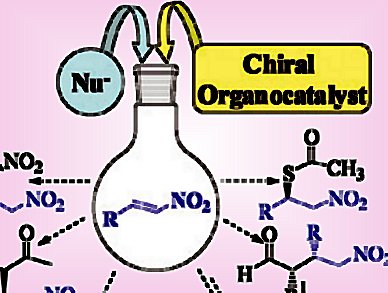The term organocatalysis refers to the acceleration of chemical reactions through the addition of a substoichiometric amount of an organic compound. The concept of organocatalysis has emerged as a hot topic in organic chemistry as a result of the novel concept and because the efficiency and selectivity of many organocatalytic reactions meet or exceed the standards of established organic reactions. Furthermore, organocatalysts tend to be tolerant towards moisture and oxygen, and as such the use of an inert atmosphere can be avoided, unlike with many metal-based catalysts.
Among the numerous asymmetric carbon–carbon bond forming reactions, catalytic asymmetric conjugate additions play a prominent role, and 1,4-additions have recently been the subject of numerous advances aimed at the discovery of efficient chiral catalysts. The importance of chiral organocatalysts in such a strategy is exemplified in a review by Svetlana B. Tsogoeva, University of Erlangen-Nürnberg, Germany.
With 500 citations (ISI Web of Science, 30.01.2012) this is the most-cited article of all articles published in 2007 in the subject category “Chemistry, Organic”, according to ISI Web of Science.
We congratulate Professor Tsogoeva and her co-workers for this great success.
Image: © Wiley-VCH
- Recent Advances in Asymmetric Organocatalytic 1,4-Conjugate Additions,
Svetlana B. Tsogoeva,
Eur. J. Org. Chem. 2007, 11, 1701–1716.
DOI: 10.1002/ejoc.200600653
Another highly cited article by S. B. Tsogoeva:
- Silicon Lewis Acid Catalyzed [3+2] Cycloaddition Reactions of Hydrazones/Cyclopentadiene: Mild Access to Pyrazolidine Derivatives,
A. Zamfir, S. Schenker, W. Bauer, T. Clark, S. B. Tsogoeva,
Eur. J. Org. Chem. 2011, 20–21, 3706–3709.
DOI: 10.1002/ejoc.201100206




